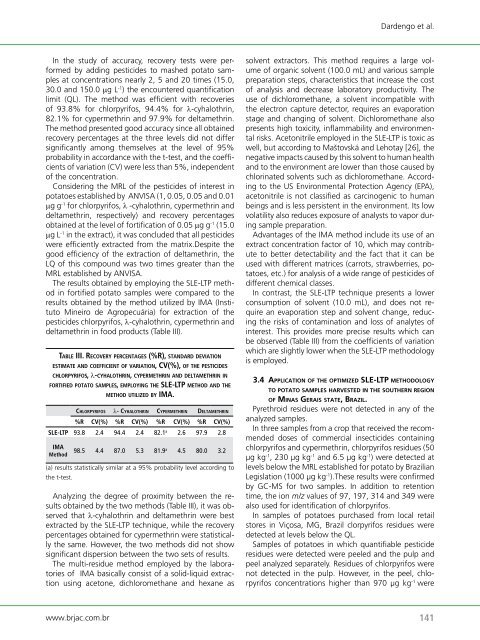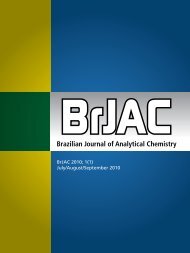Brazilian Journal of Analytical Chemistry - BRJAC - Brazilian Journal ...
Brazilian Journal of Analytical Chemistry - BRJAC - Brazilian Journal ...
Brazilian Journal of Analytical Chemistry - BRJAC - Brazilian Journal ...
Create successful ePaper yourself
Turn your PDF publications into a flip-book with our unique Google optimized e-Paper software.
In the study <strong>of</strong> accuracy, recovery tests were performed<br />
by adding pesticides to mashed potato samples<br />
at concentrations nearly 2, 5 and 20 times (15.0,<br />
30.0 and 150.0 µg L -1 ) the encountered quantification<br />
limit (QL). The method was efficient with recoveries<br />
<strong>of</strong> 93.8% for chlorpyrifos, 94.4% for λ-cyhalothrin,<br />
82.1% for cypermethrin and 97.9% for deltamethrin.<br />
The method presented good accuracy since all obtained<br />
recovery percentages at the three levels did not differ<br />
significantly among themselves at the level <strong>of</strong> 95%<br />
probability in accordance with the t-test, and the coefficients<br />
<strong>of</strong> variation (CV) were less than 5%, independent<br />
<strong>of</strong> the concentration.<br />
Considering the MRL <strong>of</strong> the pesticides <strong>of</strong> interest in<br />
potatoes established by ANVISA (1, 0.05, 0.05 and 0.01<br />
µg g -1 for chlorpyrifos, λ -cyhalothrin, cypermethrin and<br />
deltamethrin, respectively) and recovery percentages<br />
obtained at the level <strong>of</strong> fortification <strong>of</strong> 0.05 µg g -1 (15.0<br />
µg L -1 in the extract), it was concluded that all pesticides<br />
were efficiently extracted from the matrix.Despite the<br />
good efficiency <strong>of</strong> the extraction <strong>of</strong> deltamethrin, the<br />
LQ <strong>of</strong> this compound was two times greater than the<br />
MRL established by ANVISA.<br />
The results obtained by employing the SLE-LTP method<br />
in fortified potato samples were compared to the<br />
results obtained by the method utilized by IMA (Instituto<br />
Mineiro de Agropecuária) for extraction <strong>of</strong> the<br />
pesticides chlorpyrifos, λ-cyhalothrin, cypermethrin and<br />
deltamethrin in food products (Table III).<br />
taBlE iii. rECovEry PErCEntagEs (%r), standard dEviation<br />
EstimatE a n d C o E f f iC iE n t o f variation, Cv(%), o f thE PEstiCidEs<br />
ChlorPyrifos, λ-Cyhalothrin, CyPErmEthrin a n d dEltamEthrin in<br />
fortifiEd Potato samPlEs, E m P l o y i n g thE slE-ltP m E t h o d a n d thE<br />
m E t h o d utilizEd By ima.<br />
ChlorPyrifos λ- Cy h a l o t h r i n CyPErmEthrin dE l t a m E t h r i n<br />
%R CV(%) %R CV(%) %R CV(%) %R CV(%)<br />
SLE-LTP 93.8 2.4 94.4 2.4 82.1 a 2.6 97.9 2.8<br />
IMA<br />
Method 98.5 4.4 87.0 5.3 81.9a 4.5 80.0 3.2<br />
(a) results statistically similar at a 95% probability level according to<br />
the t-test.<br />
Analyzing the degree <strong>of</strong> proximity between the results<br />
obtained by the two methods (Table III), it was observed<br />
that λ-cyhalothrin and deltamethrin were best<br />
extracted by the SLE-LTP technique, while the recovery<br />
percentages obtained for cypermethrin were statistically<br />
the same. However, the two methods did not show<br />
significant dispersion between the two sets <strong>of</strong> results.<br />
The multi-residue method employed by the laboratories<br />
<strong>of</strong> IMA basically consist <strong>of</strong> a solid-liquid extraction<br />
using acetone, dichloromethane and hexane as<br />
www.brjac.com.br<br />
Dardengo et al.<br />
solvent extractors. This method requires a large volume<br />
<strong>of</strong> organic solvent (100.0 mL) and various sample<br />
preparation steps, characteristics that increase the cost<br />
<strong>of</strong> analysis and decrease laboratory productivity. The<br />
use <strong>of</strong> dichloromethane, a solvent incompatible with<br />
the electron capture detector, requires an evaporation<br />
stage and changing <strong>of</strong> solvent. Dichloromethane also<br />
presents high toxicity, inflammability and environmental<br />
risks. Acetonitrile employed in the SLE-LTP is toxic as<br />
well, but according to Maštovská and Lehotay [26], the<br />
negative impacts caused by this solvent to human health<br />
and to the environment are lower than those caused by<br />
chlorinated solvents such as dichloromethane. According<br />
to the US Environmental Protection Agency (EPA),<br />
acetonitrile is not classified as carcinogenic to human<br />
beings and is less persistent in the environment. Its low<br />
volatility also reduces exposure <strong>of</strong> analysts to vapor during<br />
sample preparation.<br />
Advantages <strong>of</strong> the IMA method include its use <strong>of</strong> an<br />
extract concentration factor <strong>of</strong> 10, which may contribute<br />
to better detectability and the fact that it can be<br />
used with different matrices (carrots, strawberries, potatoes,<br />
etc.) for analysis <strong>of</strong> a wide range <strong>of</strong> pesticides <strong>of</strong><br />
different chemical classes.<br />
In contrast, the SLE-LTP technique presents a lower<br />
consumption <strong>of</strong> solvent (10.0 mL), and does not require<br />
an evaporation step and solvent change, reducing<br />
the risks <strong>of</strong> contamination and loss <strong>of</strong> analytes <strong>of</strong><br />
interest. This provides more precise results which can<br />
be observed (Table III) from the coefficients <strong>of</strong> variation<br />
which are slightly lower when the SLE-LTP methodology<br />
is employed.<br />
3.4 applIcatIon o f t h e optImIzed sle-ltp m e t h o d o l o g y<br />
to potato samples harvested In t h e souther n r e g Io n<br />
o f mIn a s ge r a Is state, br a z Il.<br />
Pyrethroid residues were not detected in any <strong>of</strong> the<br />
analyzed samples.<br />
In three samples from a crop that received the recommended<br />
doses <strong>of</strong> commercial insecticides containing<br />
chlorpyrifos and cypermethrin, chlorpyrifos residues (50<br />
µg kg -1 , 230 µg kg -1 and 6.5 µg kg -1 ) were detected at<br />
levels below the MRL established for potato by <strong>Brazilian</strong><br />
Legislation (1000 µg kg -1 ).These results were confirmed<br />
by GC-MS for two samples. In addition to retention<br />
time, the ion m/z values <strong>of</strong> 97, 197, 314 and 349 were<br />
also used for identification <strong>of</strong> chlorpyrifos.<br />
In samples <strong>of</strong> potatoes purchased from local retail<br />
stores in Viçosa, MG, Brazil clorpyrifos residues were<br />
detected at levels below the QL.<br />
Samples <strong>of</strong> potatoes in which quantifiable pesticide<br />
residues were detected were peeled and the pulp and<br />
peel analyzed separately. Residues <strong>of</strong> chlorpyrifos were<br />
not detected in the pulp. However, in the peel, chlorpyrifos<br />
concentrations higher than 970 µg kg -1 were<br />
141



